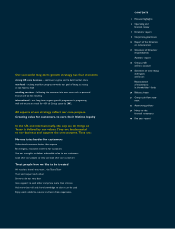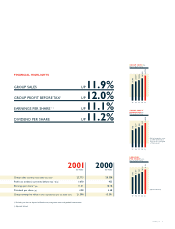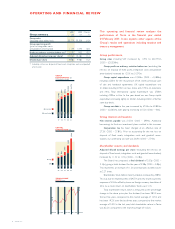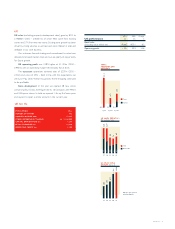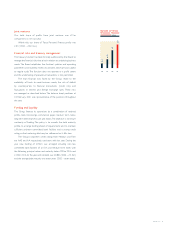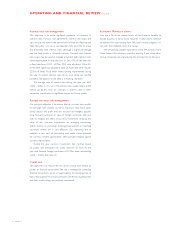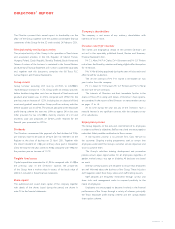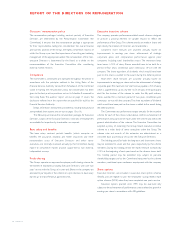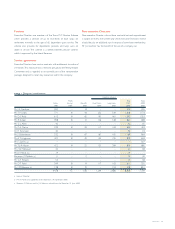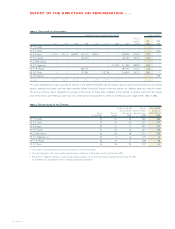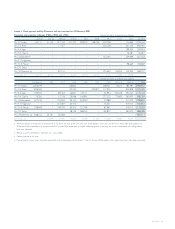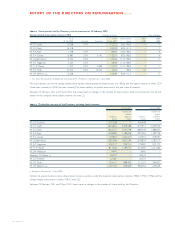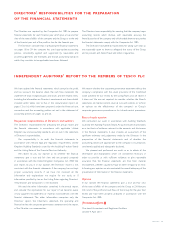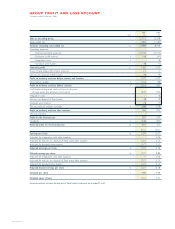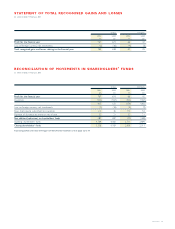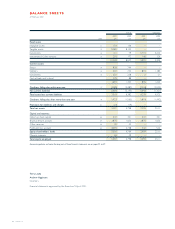Tesco 2001 Annual Report Download - page 12
Download and view the complete annual report
Please find page 12 of the 2001 Tesco annual report below. You can navigate through the pages in the report by either clicking on the pages listed below, or by using the keyword search tool below to find specific information within the annual report.10 TESCO PLC
Accountability and audit
The Board has an Audit Committee, chaired by Mr J W Melbourn and
consisting entirely of Non-executive Directors, which meets a
minimum of three times a year. Membership of the Audit Committee
is set out in the table on page 11. Its terms of reference represent
current best practice. The Committee’s primary responsibilities include
monitoring the system of internal control throughout the Group,
approving the Group’s accounting policies and reviewing the interim
and annual financial statements before submission to the Board. In
terms of financial reporting, an assessment of Group performance is
set out in the operating and financial review on pages 2 to 6.
Internal control
The Board has overall responsibility for internal control, including the
system of risk management, and sets appropriate policies having
regard to the objectives of the Group. Executive management has
the responsibility for the identification, evaluation and management
of risks and for the implementation and maintenance of control
systems in accordance with the Board’s policies.
The Board, through the Audit Committee, has reviewed the
effectiveness of the systems of internal control for the accounting
year and the period to the date of approval of the financial
statements, although it should be understood that such systems are
designed to provide reasonable but not absolute assurance against
material misstatement or loss.
The Group operates an objectives-driven approach aimed at
satisfying its core purpose and goals that translates into a rolling five-
year business plan, although strategic interests are also considered
over a much longer horizon. The five-year plan covers both revenue
and capital expenditure and forms the basis of business plans for all
parts of the Group. From this the Board, together with monitoring
regimes based upon a balanced scorecard, agrees the annual revenue
and capital budgets.The scorecard sets out targets for a wide variety
of key performance indicators and a quarterly review of achievement
is considered at Board level. This process establishes the control
framework and risk appetite.
The capital investment programme is subject to formalised review
procedures requiring key criteria to be met. All major initiatives require
business cases to be prepared, normally covering a minimum period of
five years. Post-investment appraisals are also carried out.
At the macro level, the Board considers risk every time it meets
and significant risks are reviewed regularly. The two-day Board
Conference, referred to earlier, considers where future opportunities
and risks lie and helps shape our corporate strategy going forward.
At an operational level, internal controls have evolved over many years
and are subject to regular internal and external audit. Routines exist
which ensure that significant control failures or events that represent
risks to the Group’s objectives are escalated to senior management
and the Board, if necessary, on a daily, weekly and periodic basis to
allow timely corrective action to be taken.The Board acknowledges
that the Group operates in an ever-changing environment, both
externally in meeting the challenges in a competitive marketplace and
internally through the development of new business streams, systems
and procedures. The Board has established a change management
process that includes an evaluation of risks and an identification
of controls.
The Executive Committee sets aside sufficient time for an annual
assessment of the effectiveness of managing the key risks and takes
appropriate action depending upon the outcome of their assessment.
This is then communicated and discussed with the Board.
A programme of communication exists and is constantly being
developed to ensure that all staff are aware of the parameters that
constitute acceptable business performance and the expectations of
the Board in managing risk.This provides clear definition of the Group’s
purpose and goals, accountabilities, responsibilities and the scope of
permitted activities of companies within the Group, executive functions
and individual staff.The Group employs over 240,000 people including
over 1,600 senior managers. Management control is formalised at all
levels and is regulated by cascading limits of authority.
Underpinning the internal control process is the whole system of
monitoring risk and control. The monitoring of strategic and
operational risks are responsibilities of the Board and line managers
respectively. The internal audit function also operates on a risk-based
approach providing a level of expertise to management in fulfilling their
risk responsibilities and assisting in the mapping of risks and controls.
PricewaterhouseCoopers, our external auditors, contribute a further
independent perspective on certain aspects of the internal financial
control system arising from their work and annually report their
findings to the Audit Committee. Overall, the Audit Committee seeks
to ensure that the whole management processes provide adequate
control mechanisms over all major risks to the Group.
To ensure that the international expansion of the Group takes
place within agreed policies and procedures, two further control
committees have been established, reporting to the Audit Committee.
They focus on activities in Europe and Asia respectively.
Other specialist functions within the Group, notably Trading Law
and Technical and Company Secretariat, provide assurance and advice
on health and safety, regulatory and legal compliance and
environmental issues.These functions report their findings on a regular
basis to the Compliance Committee.
CORPORATE GOVERNANCE continued


